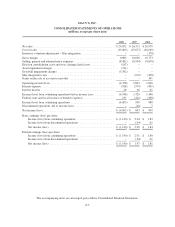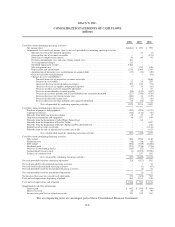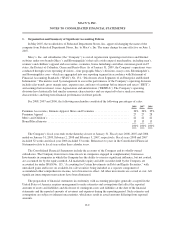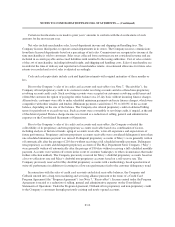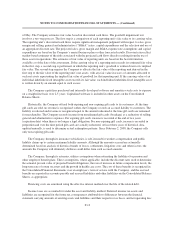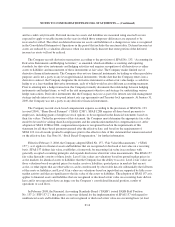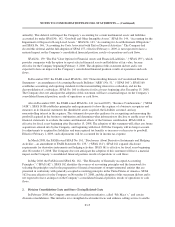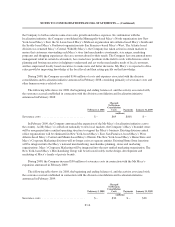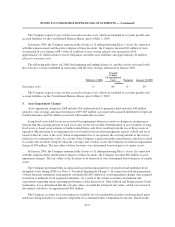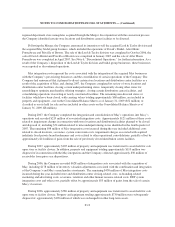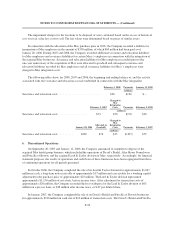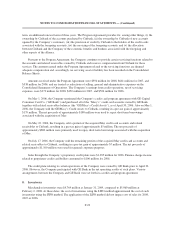Macy's 2008 Annual Report Download - page 61
Download and view the complete annual report
Please find page 61 of the 2008 Macy's annual report below. You can navigate through the pages in the report by either clicking on the pages listed below, or by using the keyword search tool below to find specific information within the annual report.
NOTES TO CONSOLIDATED FINANCIAL STATEMENTS — (Continued)
of May. The Company estimates fair value based on discounted cash flows. The goodwill impairment test
involves a two-step process. The first step is a comparison of each reporting unit’s fair value to its carrying value.
The reporting unit’s discounted cash flows require significant management judgment with respect to sales, gross
margin and selling, general and administrative (“SG&A”) rates, capital expenditures and the selection and use of
an appropriate discount rate. The projected sales, gross margin and SG&A expense rate assumptions and capital
expenditures are based on the Company’s annual business plan or other forecasted results. Discount rates reflect
market-based estimates of the risks associated with the projected cash flows directly resulting from the use of
those assets in operations. The estimates of fair value of reporting units are based on the best information
available as of the date of the assessment. If the carrying value of a reporting unit exceeds its estimated fair value
in the first step, a second step is performed, in which the reporting unit’s goodwill is written down to its implied
fair value. The second step requires the Company to allocate the fair value of the reporting unit derived in the
first step to the fair value of the reporting unit’s net assets, with any fair value in excess of amounts allocated to
such net assets representing the implied fair value of goodwill for that reporting unit. If the carrying value of an
individual indefinite-lived intangible asset exceeds its fair value, such individual indefinite-lived intangible asset
is written down by an amount equal to such excess.
The Company capitalizes purchased and internally developed software and amortizes such costs to expense
on a straight-line basis over 2-5 years. Capitalized software is included in other assets on the Consolidated
Balance Sheets.
Historically, the Company offered both expiring and non-expiring gift cards to its customers. At the time
gift cards are sold, no revenue is recognized; rather, the Company records an accrued liability to customers. The
liability is relieved and revenue is recognized equal to the amount redeemed at the time gift cards are redeemed
for merchandise. The Company records income from unredeemed gift cards (breakage) as a reduction of selling,
general and administrative expenses. For expiring gift cards, income is recorded at the end of two years
(expiration date) when there is no longer a legal obligation. For non-expiring gift cards, income is recorded in
proportion and over the time period gift cards are actually redeemed. At least three years of historical data,
updated annually, is used to determine actual redemption patterns. Since February 2, 2008, the Company sells
only non-expiring gift cards.
The Company, through its insurance subsidiaries, is self-insured for workers compensation and public
liability claims up to certain maximum liability amounts. Although the amounts accrued are actuarially
determined based on analysis of historical trends of losses, settlements, litigation costs and other factors, the
amounts the Company will ultimately disburse could differ from such accrued amounts.
The Company, through its actuaries, utilizes assumptions when estimating the liabilities for pension and
other employee benefit plans. These assumptions, where applicable, include the discount rates used to determine
the actuarial present value of projected benefit obligations, the rate of increase in future compensation levels, the
long-term rate of return on assets and the growth in health care costs. The cost of these benefits is recognized in
the Consolidated Financial Statements over an employee’s term of service with the Company, and the accrued
benefits are reported in accounts payable and accrued liabilities and other liabilities on the Consolidated Balance
Sheets, as appropriate.
Financing costs are amortized using the effective interest method over the life of the related debt.
Income taxes are accounted for under the asset and liability method. Deferred income tax assets and
liabilities are recognized for the future tax consequences attributable to differences between the financial
statement carrying amounts of existing assets and liabilities and their respective tax bases, and net operating loss
F-13




